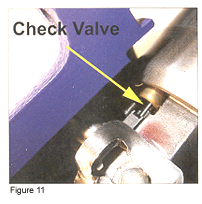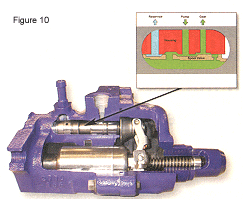To troubleshoot a Hydroboost brake system, first check for leaks and ensure the power steering fluid is at the correct level. Next, inspect the power steering pump for proper operation.
Understanding the Hydroboost brake system is crucial for maintaining your vehicle’s safety and performance. This system utilizes hydraulic pressure from the power steering pump to assist in braking, offering a more efficient response than traditional vacuum-assisted brakes. Troubleshooting this system involves a systematic approach, starting with the most accessible components like fluid levels and condition.
Ensuring there are no leaks in the system and that the power steering pump is functioning correctly are critical first steps. Regular maintenance and prompt attention to any signs of malfunction can prevent more significant issues, keeping your braking system responsive and reliable. Whether you’re a seasoned mechanic or a concerned vehicle owner, grasping the basics of Hydroboost brake system troubleshooting is invaluable for ensuring your vehicle remains safe and roadworthy.
Introduction To Hydroboost Brake Systems
Hydroboost brake systems are a vital component in modern vehicles. They use the power of the vehicle’s hydraulic pressure to assist in braking. This results in a more responsive and effective brake system. Understanding Hydroboost is essential for safe driving.
The Role Of Hydroboost In Modern Vehicles
Hydroboost systems provide power assist to the braking system. This allows for smoother and more consistent braking. With Hydroboost, even when the engine fails, the brakes still function. It gives drivers better control in demanding situations.
Benefits Of Hydroboost Over Traditional Systems
There are several advantages of Hydroboost over traditional vacuum-assisted brakes:
- Improved braking power: Hydroboost can generate more force than vacuum systems.
- Consistent performance: It works well at all engine speeds, unlike vacuum systems.
- Less space: The Hydroboost unit is more compact, freeing up engine space.
- Engine compatibility: Hydroboost is ideal for diesel engines that lack sufficient vacuum.
These benefits make Hydroboost a preferred choice for many modern vehicles.
Common Hydroboost Brake System Issues
The Hydroboost brake system is vital for safe driving. It uses hydraulic pressure from the power steering pump to boost brake performance. Like any system, it can face issues that affect your vehicle’s braking ability. Let’s explore the common troubles and how to spot them.
Symptoms Of Hydroboost Failure
Recognizing signs of Hydroboost failure is key to a quick fix. Look out for these symptoms:
- Hard brake pedal: It takes more effort to press down.
- Leaking fluids: You might find puddles under the car.
- Engine stalling: This can happen when the brake is applied.
- Whining noise: It comes from the power steering pump.
Identifying The Source Of The Problem
To fix the issue, find the exact problem source. Steps include:
- Check power steering fluid level.
- Inspect for leaks in the brake lines.
- Test the power steering pump pressure.
- Examine the Hydroboost unit itself.
Use a mechanic’s expertise if needed. They will ensure your brakes are safe again.
Initial Diagnostic Steps
When your vehicle’s stopping power starts to fade, the Hydroboost brake system could be the culprit. Understanding the initial diagnostic steps is crucial. Let’s dive into how to troubleshoot this advanced braking system.
Checking Brake Fluid Levels
Brake fluid is the lifeblood of any Hydroboost system. Begin with a simple check of the brake fluid reservoir. Here’s how:
- Locate the reservoir under the hood.
- Ensure the fluid reaches the ‘Full’ mark.
- Check for color and clarity of the fluid.
If levels are low or the fluid looks dirty, it may be time for a top-up or change.
Inspecting For External Leaks
Leaks can cripple a Hydroboost system’s performance. Spotting them early is key. Follow these steps:
- Inspect all hoses and connections.
- Look for wet or oily spots.
- Pay attention to the Hydroboost unit itself.
Any signs of fluid outside the system suggest a leak that needs fixing.
Quick Fix: Bleeding The Brake System
Many drivers face brake system issues. A quick fix could be to bleed the brakes. This helps remove air from brake lines. Let’s explore how to do this.
Step-by-step Bleeding Procedure
Bleeding your Hydroboost brake system is straightforward. Follow these steps:
- Locate the Bleeder Valve: Find this on the brake caliper.
- Prepare the Brake Fluid: Use new, correct type fluid.
- Attach Bleeding Tube: Place one end on the valve, other in a container.
- Depress the Brake Pedal: Have someone push the pedal down.
- Open the Bleeder Valve: Turn it to let out fluid and air.
- Close the Valve: Do this before releasing the brake pedal.
- Repeat: Continue until no air bubbles appear in the fluid.
- Check Fluid Level: Ensure the master cylinder is full.
Precautions And Tips For Effective Bleeding
Bleeding brakes needs care. Follow these tips:
- Use the Right Fluid: Check your vehicle’s manual for this.
- Keep the Master Cylinder Full: Prevent air from entering the system.
- Check for Leaks: Inspect brake lines and fittings.
- Wear Safety Gear: Protect eyes and skin from brake fluid.
- Dispose of Old Fluid Properly: It’s hazardous waste.
- Work in a Ventilated Area: Brake fluid fumes can be harmful.
Power Steering Pump Inspection
Brake issues can often stem from the power steering pump. This part of your Hydroboost brake system needs regular checks. Let’s look at how to inspect your power steering pump properly.
Assessing Pump Performance
Listen for noises when the engine runs. A well-functioning pump is quiet. Any whines or groans could signal trouble.
Check the fluid level and quality. Low or dirty fluid can cause poor performance. The fluid should be a clear red, not dark or cloudy.
Feel the steering wheel as you turn it. It should move smoothly. Any stiffness or jerkiness suggests pump issues.
Inspect the pump belt for cracks or frays. A damaged belt affects pump performance.
When To Consider Pump Replacement
Age and mileage are key factors. Pumps typically last around 100,000 miles.
If the pump is leaking, it’s time for a new one. Leaks can quickly lead to system failure.
Persistent noises or steering issues after fluid changes mean a replacement may be necessary.
Consider your safety. A failing pump can lead to brake failure. Don’t wait to replace it.
Hydroboost Unit Maintenance
Maintaining your Hydroboost brake system is key for safe driving. Regular checks keep brakes responsive. Let’s dive into proper Hydroboost unit upkeep.
Cleaning The Hydroboost Unit
Over time, dirt and grime can build up on your Hydroboost unit. This can lead to brake issues. A clean Hydroboost unit functions better and lasts longer.
- Turn off the engine before cleaning.
- Use a soft cloth and mild cleaner.
- Wipe the unit gently.
- Avoid harsh chemicals that can damage seals.
Routine Servicing Recommendations
Regular service prevents Hydroboost system failure. Follow these steps for optimal performance:
| Service Task | Frequency |
|---|---|
| Check for leaks | Every oil change |
| Inspect hoses and fittings | Every oil change |
| Test brake fluid pressure | Annually |
| Flush brake fluid | Every 2 years |
- Inspect the Hydroboost unit for leaks regularly.
- Replace worn parts promptly to avoid brake failure.
- Ensure the brake fluid is clean and at the proper level.
Replacing Faulty Hydroboost Components
Safe driving needs a reliable brake system. Hydroboost systems use power steering fluid to boost braking. Over time, parts wear out. It’s vital to spot and replace these parts to maintain brake performance. This guide will help you identify and replace faulty Hydroboost components.
Identifying Worn Or Damaged Parts
Regular checks can reveal Hydroboost issues. Look for fluid leaks and listen for strange noises. Check for a spongy brake pedal. Feel for vibrations during braking. These signs suggest worn parts. Immediate action can prevent further damage.
- Fluid leaks – Check for wet spots around the Hydroboost unit.
- Noises – Listen for hisses or groans when you brake.
- Spongy pedal – If the brake pedal feels soft, inspect your Hydroboost.
- Vibrations – Shaking when braking means something’s not right.
Guidelines For Component Replacement
Replacing Hydroboost parts can be tricky. Follow these steps for a smooth process. Use the right tools and parts. Always bleed your brake system after replacement.
- Preparation – Gather all necessary tools and replacement parts.
- Disassembly – Carefully remove the faulty Hydroboost unit.
- Installation – Fit the new component as per the manufacturer’s guide.
- Bleeding – Remove air from the brake system to restore full function.
Note: Always refer to your vehicle’s service manual for specific instructions. Professional help is advised for those unfamiliar with brake systems.
| Step | Action | Tip |
|---|---|---|
| 1 | Check for leaks | Use a flashlight for better visibility. |
| 2 | Listen for noise | Do this in a quiet area. |
| 3 | Feel pedal firmness | Compare with a known good system. |
| 4 | Inspect vibrations | Have a helper apply the brakes while checking. |
Master Cylinder Considerations
The master cylinder is a core part of the hydroboost brake system. It needs regular checks for safe driving. Let’s dive into how to test its function and understand its impact on your brakes.
Testing Master Cylinder Function
To test the master cylinder, follow these steps:
- Check for leaks around the master cylinder.
- Inspect the fluid level in the reservoir.
- Press the brake pedal to gauge response.
- If the pedal sinks, the cylinder may be faulty.
Use a pressure gauge to measure output. This will confirm the cylinder’s health.
How Master Cylinder Issues Affect Hydroboost
Master cylinder problems can lead to weak brakes. Here’s what might happen:
- Brake pedal feels spongy or soft.
- Stopping power is reduced.
- Brakes may fail completely in severe cases.
Ensure the master cylinder works right to keep the hydroboost system effective.
When To Seek Professional Help
Troubleshooting a Hydroboost brake system can be complex. Certain issues require a skilled mechanic. Recognize when to call a professional to ensure safety and proper functionality.
Limitations Of Diy Troubleshooting
DIY efforts have limits. Without specialized tools and expertise, you might misdiagnose problems. This could lead to unsafe brakes. Consider these scenarios:
- Unfamiliar brake system noises
- Persistent brake fluid leaks
- Brake pedal feels too hard or too soft
Expert insight prevents further damage. A mechanic has diagnostic equipment for accurate assessments.
Finding A Qualified Mechanic
Select a mechanic with Hydroboost experience. Look for certifications and positive reviews. Here’s a checklist for finding the best:
| Certification | Experience | Reviews |
|---|---|---|
| ASE certification | Specialized in brake systems | High customer satisfaction |
Word of mouth and online forums can lead to reputable mechanics. Trust your vehicle to a pro for peace of mind.

Credit: www.brakeandfrontend.com
Preventative Measures And Best Practices
Keeping your Hydroboost brake system in top shape is crucial. Here, we cover preventative measures and best practices. These tips help avoid common issues. Follow them for a safer driving experience.
Regular Maintenance Schedule
Maintaining your Hydroboost system is key. A regular checkup prevents big problems.
- Check fluid levels monthly. Low levels can cause damage.
- Inspect for leaks often. Spotting them early saves money.
- Replace worn parts immediately. This keeps everything running smoothly.
Use this table for a quick maintenance checklist:
| Task | Frequency |
|---|---|
| Check fluid levels | Monthly |
| Inspect hoses and connections | Every oil change |
| Replace fluids | Every 2 years |
Upgrading Hydroboost System For Performance
Upgrades can boost your system’s performance. They make your ride smoother.
- Install high-performance brakes. They handle more pressure.
- Use a high-quality brake fluid. It lasts longer and performs better.
- Consider a bigger brake booster. It gives you more power.
Remember, upgrading requires professional help. Always consult an expert.
Conclusion: Ensuring Longevity Of Your Hydroboost System
Maintaining your Hydroboost brake system is key to safe driving. This guide helps ensure its longevity. Follow these steps to keep your system running smoothly.
Key Takeaways From Troubleshooting
- Regular checks prevent major issues.
- Early detection of leaks or damage is crucial.
- Use quality parts for replacements.
- Maintenance extends the system’s life.
The Importance Of Timely Repairs
Delaying repairs can lead to bigger problems. Act fast to fix issues. This keeps the system reliable. It also makes your vehicle safer to drive.
| Problem | Solution | Impact |
|---|---|---|
| Leakage | Seal replacement | Prevents fluid loss |
| Noisy pump | Check fluid levels | Ensures smooth operation |
| Hard steering | System bleed | Improves steering response |

Credit: www.brakeandfrontend.com

Credit: www.hydraulicstatic.com
Frequently Asked Questions
What Are The Symptoms Of A Bad Hydroboost?
Symptoms of a bad Hydroboost include hard brake pedal, leaking power steering fluid, and diminished braking performance. You may also notice strange noises when braking. Regular checks can prevent these issues.
How Do You Diagnose A Hydroboost Brake System?
To diagnose a Hydroboost brake system, first check for fluid leaks and belt condition. Test pedal resistance and return. Inspect for power steering issues, as they impact Hydroboost performance. Finally, evaluate brake response during engine idle and acceleration.
How Do I Know If My Hydraulic Brake Booster Is Bad?
Signs of a failing hydraulic brake booster include a hard brake pedal, reduced braking power, strange noises when braking, and a sinking or spongy pedal feel.
How Do You Bleed Air Out Of Hydroboost?
To bleed air out of Hydroboost, turn the steering wheel lock to lock, start the engine, and repeat the process.
What Causes Hydroboost Brake Failure?
Hydroboost brake systems can fail due to leaks in the power steering fluid lines, a malfunctioning power steering pump, or a defective hydroboost unit itself.
Conclusion
Navigating the complexities of hydroboost brake systems doesn’t have to be daunting. Armed with the right knowledge and troubleshooting tips, you can ensure your vehicle’s braking performance is at its peak. Remember, regular maintenance is key. By staying vigilant and addressing issues promptly, you’ll enjoy safer, more reliable driving experiences.














